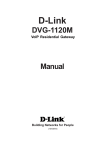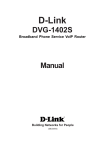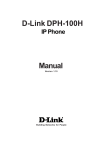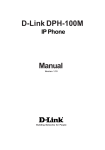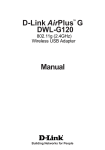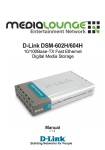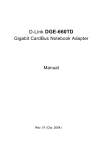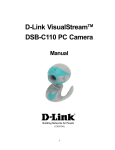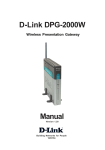Download D-Link DVG-1120M Specifications
Transcript
D-Link DVG-1120M VoIP Residential Gateway Manual Building Networks for People (10/08/04) Downloaded from www.Manualslib.com manuals search engine Contents Package Contents ................................................................................3 Introduction............................................................................................4 Connections .......................................................................................... 5 Features and Benefits ...........................................................................6 LEDs ....................................................................................................7 Web-based Management ......................................................................8 Technical Specifications ......................................................................29 Technical Support ................................................................................32 Warranty ..............................................................................................33 Registration ........................................................................................36 2 Downloaded from www.Manualslib.com manuals search engine Package Contents Contents of Package: D-Link DVG-1120M VoIP Residential Gateway A/C Power Adapter CAT5-RJ-45 Ethernet Cable (Blue) RJ-11 Telephone Cord (Gray) Quick Installation Guide Note: Using a power supply with a different voltage rating than the one included with the DVG-1120M will cause damage and void the warranty for this product. If any of the above items are missing, please contact your reseller. System Requirements For Configuration: Computer with Windows, Macintosh, or Linux-based operating system with an installed Ethernet adapter Internet Explorer or Netscape Navigator version 4.0 or above, with JavaScript enabled At least 128MB of memory and a 500MHz processor 3 Downloaded from www.Manualslib.com manuals search engine Introduction The D-Link DVG-1120M VoIP Station Gateway links traditional telephone networks to IP networks with conventional telephone devices such as analog phones or fax machines. The DVG-1120M includes two Foreign Exchange Subscriber (FXS) interfaces with normal RJ-11 telephone connectors that provide voice/fax communication over the IP network. Two Ethernet ports are also provided. One Ethernet port is for a DSL/Cable Modem or other WAN device, and the other is for connection to create a home or small office LAN network. The built-in DHCP server and Network Address Translation (NAT) function automatically assigns IP addresses for LAN users, allowing multiple users to share a single Internet connection. You can configure and monitor the DVG1120M via the Web browser. Telnet and SNMP management is also supported. By routing calls over the Internet or any IP network, the DVG-1120M can reduce or eliminate long distance or inter-office phone charges. Corporations can also enjoy the benefits of network consolidation and reduction of leased lines by relying on the Internet service providers to deliver toll-quality voice communications over the IP networks. 4 Downloaded from www.Manualslib.com manuals search engine Connections Warning! Using a different power adapter than the one included with your purchase will damage the DVG-1120M and void the warranty. Reset Switch Used to return the device to its original configuration. This is the same as performing a factory reset. AC Power Connector Use the included power adapter. If you use a power adapter other than the one included with the product you will damage the device and void the warranty on this product. Diagnostic Port An RJ-14 port used to configure the device. (User needs a RJ14 to RS-232 converter). Plug one end of a straightthrough wired RJ-14 cable to the device and the other end to a serial port of a PC running a terminal emulation program (such as Microsoft HyperTerminal) or a VT-100 terminal. 2 PSTN/VoIP Switch to select PSTN or VoIP mode When the switch is in the down position, Phone1/2 will be in VoIP Mode. When the switch is in the up position, Phone1/2 will be configured to PSTN Mode. Ethernet WAN A 10Mbps Ethernet port fitted with an RJ-45 connector used to connect the VoIP gateway to a WAN device (e.g. Cable/ADSL Modem). This port accepts Category 3, 4 or 5 UTP cabling with an RJ-45 connector. Downloaded from www.Manualslib.com manuals search engine Ethernet LAN A 10/100Mbps dual-speed Ethernet port fitted with an RJ-45 connector used to connect the VoIP gateway to a LAN device (hub, switch, PC, etc.). This port accepts Category 5 or better UTP cabling with an RJ-45 connector. 1 Phone 1 Normal RJ-11 phone jack used to connect to a telephone or fax machine. Plug your normal telephone or fax machine directly into this jack. 5 Features & Benefits One analog FXS interface port accepting an RJ-11 connector to facilitate a VoIP connection One 10Mbps WAN port for connecting to a DSL/Cable Modem or other WAN devices One 10/100Mbps LAN port for connecting to a local network IP address assignment using DHCP (Dynamic Host Configuration Protocol) or static configuration IP Routing support (RIP1, RIP2 and Static Routing) Remote software download/update Supports IP sharing to allow multiple users to access the Internet via a single IP address Built-in PPPoE function to support dial-up connection for broadband technology Supports Caller ID Supports QoS to guarantee voice quality Automatic Call Redirection (ACR) function support VoIP line automatic selection (e.g. 110, 119) VoIP routing table support 6 Downloaded from www.Manualslib.com manuals search engine LEDS Power This LED is lit when the device is receiving power; otherwise, it is unlit. Status/Alarm This LED will remain green when the CPE is either performing a self-test or booting up. The LED will flash green slowly when the system is ready for a connection with the Call Agent. It will remain red when the self-test or booting up is failed. It will flash red slowly when the system is ready but cannot receive an acknowledgment from the Call Agent. Ethernet - This LED displays the connection speed, link status, and activity on the 10/100 dual-speed Ethernet port that is used to connect to your LAN. 10/100M - This indicator remains unlit when there is no connection, or the port is operating at 10Mbps through a connection to a 10BASET device. It is lit when the port is operating at 100Mbps through a connection to a dual-speed or 100BASE-TX Fast Ethernet device. Link/Act - When a good link to a powered-up but idle device is detected on a port, this indicator shines steadily. When packets are received from the device, the indicator blinks off and on. Downloaded from www.Manualslib.com manuals search engine WAN This LED displays the link status and activity on the 10M Ethernet port that is used to connect to your WAN device (usually a Cable or ADSL Modem). When a good link to a powered-up but idle device is detected on a port, the WAN indicator shines steadily. When packets are received from the device, the indicator blinks off and on. Phone 1 - This LED displays the activity on the RJ-11 port that is used to connect to your normal telephone/fax machine line. Hook/Ringing - When an offhook action is detected on a phone port, this indicator shines steadily. When a ringing signal is received from the device, the indicator blinks off and on. 7 Web-based Management In order to use a web browser to configure the VoIP gateway, you must make sure it has a valid Ethernet connection to a PC or LAN via its LAN port. Access the configuration utility to check the LAN port by entering the IP Address into your web browser address field. Type 192.168.15.1 (the IP Address) into the address field of your browser. http://192.168.15.1 Click on Login to the Web-based Management module 8 Downloaded from www.Manualslib.com manuals search engine Web-based Management (continued) Setting Up the Connection To configure the WAN port, please do the following: Click on Configure WAN Port. Manually input the WAN IP Address here. Then go to Start>Control Panel>Network Connections>Right-click local area connection >select Properties> double click Internet Protocol (TCP/IP). The screen at right will appear. The VoIP gateway’s WAN port comes with DHCP as default IP setting. If the VoIP gateway cannot get the assigned DHCP IP, it will use the manual IP (default is 10.1.10.5 ) as it’s default IP. Make sure the PC is in the same IP domain as the VoIP gateway. You can do this by changing the IP address of the PC as shown here. Downloaded from www.Manualslib.com manuals search engine 9 Web-based Management (continued) To configure the LAN port for the device, please do the following: Click on Configure LAN Port. In this configuration menu, users can configure the LAN IP Address. (Recommended for advanced users.) By default the LAN IP Address is: 192.168.15.1 After you have configured your WAN and LAN ports you can click on Save and Restart System in the Configuration menu, or you can continue to configure the VoIP. After you have completed configuring the VoIP, you must Save and Restart the System or your changes will not be saved. 10 Downloaded from www.Manualslib.com manuals search engine Web-based Management (continued) Configure LAN Port > Proxy DNS State - This toggles Enable and Disable for the Proxy DNS function. Proxy DNS IP Address - Enter the Proxy DNS IP address if instructed by your service provider. Click Save to save the settings. Configure LAN Port > Bridge Mode Bridge Mode - This toggles On and Off to turn NAT on or off for Static Public IP assignment. Click Save to save the settings. 11 Downloaded from www.Manualslib.com manuals search engine Web-based Management (continued) Configure LAN Port > DHCP Configuration > Dynamic IP Assignment Use the Dynamic IP Assignment to configure the device to act as a DHCP server for the LAN. The items on this window are described below: Default Gateway - This specifies the Gateway IP Address that will be assigned to and used by the DHCP clients. Start IP Address -This is the base (starting) address for the IP pool of unassigned IP addresses. IP Range - This is the range of contiguous, IP addresses above the base IP Address above. Netmask - This mask informs the client, how the destination IP address is to be divided into network, subnet, and host parts. The netmask has ones in the bit positions in the 32-bit address which are to be used for the network and subnet parts, and zeros for the host part. Leased Time - This specifies the amount of time (in seconds) a client can lease an IP address, from the dynamically allocated IP pool. DNS Server IP - This specifies the Domain Name System server, used by the DHCP clients using leased IP addresses, to translate hostnames into IP addresses or vice-versa. WIN Server IP - Some LANs may require using WINS servers; enter the IP address of the WINS server or leave blank. Domain Name - Enter a domain name for the network group or leave blank. State - This toggles Disable and Enable for the DHCP function. Click Save to save the settings. Downloaded from www.Manualslib.com manuals search engine 12 Web-based Management (continued) Configure LAN Port > DHCP Configuration > Static IP Assignment The Static IP Assignment functions in much the same way as the Dynamic IP Assignment. The only difference is that a particular IP address can be assigned to a particular host. The host is identified by the MAC Address of its NIC which must be entered on next screen. Click the edit icon on the window above to access the second Static IP Assignment window: The items on this window are described below: Index - Choose the index number that you would like to edit (From 1 to 4). MAC Address - This specifies the physical address of the particular host that will receive the below IP address. IP Address - This is the static IP address to be assigned. All other parameters (Netmask, Gateway, DNS Server IP, WINS Server IP, Domain Name and State) are identical to those in the Dynamic IP Assignment, in the previous section. Click Save to save the settings. Downloaded from www.Manualslib.com manuals search engine 13 Web-based Management (continued) Configure LAN Port > NAT Configuration Select enabled or disabled for the NAT function. Click Save to save the settings. Configure LAN Port > NAT Configuration > Virtual Server Configuration This window allows you to view the current virtual server configuration settings. Click the edit icon on this window to access the second Virtual Server Configuration window: 14 Downloaded from www.Manualslib.com manuals search engine Web-based Management (continued) Configure LAN Port > NAT Configuration > Virtual Server Configuration (continued) The items on this window are described below: Index - Choose the index number that you would like to edit (Form 1 to 6). Protocol - Choose the protocol either TCP or UDP. Global Port Range Enter the designated TCP or UDP protocol port number for the particular protocol packet you wish to redirect. Local Port Range - Enter the port number used by the designated host on the LAN or use a well-known port. Server IP - Enter the IP address of the local designated host computer or device. State - This toggles Disable and Enable for the Virtual Server Configuration function. Click Save to save the settings. 15 Downloaded from www.Manualslib.com manuals search engine Web-based Management (continued) Configure LAN Port > NAT Configuration > Dynamic NAT This window allows you to view the current Dynamic NAT settings. Click the edit icon on this window to access the second Dynamic NAT window: The items on this window are described below: Index - Choose the index number that you would like to edit (Form 1 to 6). Global IP Start - Enter the beginning designated IP address for the particular range of packets you wish to redirect to local addresses. Global IP End - Enter the end designated IP address for the particular range of packets you wish to redirect to local addresses. Local IP Start - Enter the beginning designated IP address for the particular range of packets you wish to redirect to Global addresses. Local IP End - Enter the end designated IP address for the particular range of packets you wish to redirect to Global addresses. State - This toggles Disable and Enable for the Dynamic NAT function. Click Save to save the settings. Downloaded from www.Manualslib.com manuals search engine 16 Web-based Management (continued) Configure LAN Port > NAT Configuration > Static NAT This window allows you to view the current Static NAT settings. Click the edit icon on this window to access the second Static NAT window: The items on this window are described below: Index - Choose the index number that you would like to edit (Form 1 to 6). Local IP Address - Enter the designated IP address for the packet you wish to redirect to a Global address. Global IP Address - Enter the designated IP address for the packet you wish to redirect to a Local address. State - This toggles Disable and Enable for the Static NAT function for this index. Click Save to save the settings. Downloaded from www.Manualslib.com manuals search engine 17 Web-based Management (continued) Configure LAN Port > Routing > RIP Select to use RIPv1, RIPv2 or On (both versions) for the LAN and WAN interface. To disable both versions of RIP select Off. Click Save to save the settings. RIP - Routing Information Protocol that specifies how routers exchange information. With RIP, routers periodically exchange entire tables. Configure LAN Port > Routing > Static Route Configuration Use Static Routing to specify a route used for data traffic within your WAN or LAN. This can be used to specify that all packets destined for a particular subnet use a predetermined gateway. Click the edit icon on the window above to access the second Static Route Configuration window: 18 Downloaded from www.Manualslib.com manuals search engine Web-based Management (continued) Configure LAN Port > RIP > Static Route Configuration (continued) The items on this window are described below: IP Address - Type in the IP Address of the subnet or device where packets are routed. Subnet Mask - Type in an appropriate subnet mask that allows the static route to function. Gateway - Type in the IP Address of the gateway used for traffic destined for the specified subnet or device. Interface - Select WAN or LAN Interface. Metric - Type in the maximum number of hops allowed for the static route. State - Enable or disable the route. Click Save or Clear to Save or Clear the settings. 19 Downloaded from www.Manualslib.com manuals search engine Web-based Management (continued) Firewall Rules Firewall Rules is an advance feature used to deny or allow traffic from passing through the device. The filtering sets are sets of rules defined in the menus shown below. Click the edit icon on the window above to access the Firewall Rules window for the first rules set: Type in an appropriate identifying comment for the Firewall Rules set. When you are finished defining the rules for each set, select enabled or disabled to enable or disable the listed Firewall rules sets. Click Save button to save the settings. Click the edit icon on the window above to access the third IP Filter window, shown on the following page: 20 Downloaded from www.Manualslib.com manuals search engine Web-based Management (continued) Firewall Rules (continued) Comment- Type in an appropriate identifying comment for the rule. Pass or Block- Select Pass or Block to perform this action on packets as defined below. Direction- Select In or Out to pass or block packets coming in or going out of the network. Protocol-Select IGMP, TCP, UDP or All to pass or block packets of that protocol type. Source- Type in the source IP Address and select the Subnet Mask to pass or block packets from that IP Address. Destination- Type in the destination IP Address and select the Subnet Mask to pass or block packets destined to that IP Address. Port Filter Rule- UDP and TCP packets only. Select a range of ports to pass or block. Use the following guide to define the port or port range (Start Port and End Port): < : specifies the port numbers less than and equal to the Start Port number > : specifies the port numbers greater than and equal to the Start Port number = : sets the port number equal to the Start Port if there is no End Port specified; if an End Port number is specified, this defines a range of ports to filter. The range is defined as the port numbers between the Start Port and End Port, including the Start and End Port numbers. ≠ : the port number does not equal the Start Port if there is no End Port specified; if an End Port number is specified, this defines a range of ports not to filter. The range is defined as the port numbers between the Start Port and End Port, including the Start and End Port numbers. 21 Downloaded from www.Manualslib.com manuals search engine Web-based Management (continued) Firewall Rules (continued) TCP Flag - Select enabled or disabled to enable or disable the filter rule as defined in the menu. TCP Packet Options - Optional TCP packet options include: Acknowledgement, Push, Reset, SYN, and FIN. Consult a certified technician before selecting any of these advanced options. Filter Rule State - Select enabled or disabled to enable or disable the filter rule as defined in the menu. Click Save or click Clear to Save or Clear the settings. MAC Filter MAC (Media Access Control) Filters are used to deny or allow LAN (Local Area Network) computers from accessing the Internet and network by their MAC address. Click the edit icon on the window above to access the MAC Filter window, shown on the following page: 22 Downloaded from www.Manualslib.com manuals search engine Web-based Management (continued) MAC Filter (continued) The items on this window are described below: Index - This is the index number that you are editing (1-16). MAC Address - Enter the MAC address of the client that will be filtered. State - This toggles Disable and Enable for the MAC address filtering function for this index. Click the Save button to save the settings. Configure Pass Through Mode The device supports VPN (Virtual Private Network) pass-through for both PPTP (Point-to-Point Tunneling Protocol) and IPSec (IP Security). Once VPN pass-through is enabled, there is no need to open up virtual services. Multiple VPN connections can be made through the device. This is useful when you have many VPN clients on the LAN. PPTP Pass Through / IPSec Pass Through - This toggles Disable and Enable for the Pass Through function. Click the Save button to save the settings. 23 Downloaded from www.Manualslib.com manuals search engine Web-based Management (continued) Statistics > WAN Internet Connection Statistics This window displays a variety of WAN Connection statistics. Statistics > Phone Port Statistics This window displays a variety of Phone Port statistics. 24 Downloaded from www.Manualslib.com manuals search engine Web-based Management (continued) Configuration Restore and Backup The current system settings can be saved as a file onto the local hard drive. The saved file or any other saved setting file created by the DVG-1120M can be uploaded into the unit. To restore a system settings file, click on Browse to search the local hard drive for the file to be used. To backup the current system settings, click on Backup and the following window will appear: Click on the Save button and select the location on your hard drive to save the file to. 25 Downloaded from www.Manualslib.com manuals search engine Web-based Management (continued) Factory Reset Before performing a Factory Reset, be absolutely certain that this is what you want to do. Once the reset is done, all of the device’s settings stored in NVRAM will be erased and restored to values present when the device was purchased. Click on Reset to Factory Default to reset the NV-RAM to the default values that were present when you purchased the device. Note: After performing the Factory Reset, make sure to redefine the IP settings for the device in the IP Configuration menu. Then perform a Restart System on the device. After these three procedures are performed, your Factory Reset is complete. Click on Reset without losing user settings to reset the unit. This resets all settings except IP, PPPoE username/password, Notify Entity, RGW name, and DNS settings. 26 Downloaded from www.Manualslib.com manuals search engine Web-based Management (continued) Save and Restart System After the settings have been saved to NV-RAM, they will become the default settings for the device, and they will be used every time it is powered on, reset or rebooted. The only exception to this is a factory reset, which will clear all settings and restore the unit’s settings back to their initial values, which were present when the device was purchased. Click on Save Configuration at the bottom of the window to save the system settings to NV-RAM. Advanced This section contains advanced configuration settings for the DVG-1120M VoIP Station Gateway. Please consult a certified technician before making any changes to the Advanced menu. 27 Downloaded from www.Manualslib.com manuals search engine Web-based Management (continued) About This read-only window displays information about the DVG-1120M VoIP Station Gateway such as: Device Type, MAC Address, Boot PROM Firmware, Firmware Version, and DSP Version. The DSP Version will list “Not yet loaded” until you initialize your unit. 28 Downloaded from www.Manualslib.com manuals search engine Technical Specifications Call Control Protocols Compliance: MGCP Voice Compression: G.711 (A-law and u-law), G.723.1, G.729a Analog Voice Ports: Type: Loop-Start FXS interfaces DTMF tone detection/generation V.21/V.25 Modem/Fax tone detection Echo Cancellation: G.165/G.168 Ethernet Ports: WAN: 10BASE-T Ethernet port (MDI-II) LAN: NWay 10/100BASE-TX Fast Ethernet ports (MDI-X) IEEE 802.3 10BASE-T Ethernet compliance IEEE 802.3u 100BASE-TX Fast Ethernet compliant Quality of Service: Voice service is prioritized over the data traffic FAX support: V.21, V.27ter, V.29, V.17 Modulation/Demodulation Network Protocols: TCP/IP, UDP, ARP, ICMP, TFTP, Telnet, SNMP, HTTP, RIP1/ RIP2 DHCP: Dynamic Host Configuration Protocol server and client NAT: Network Address Translation PPP over Ethernet Client 29 Downloaded from www.Manualslib.com manuals search engine Technical Specifications (continued) Network Management: SNMP management agent base MIB II Telnet provisioning Manage functions through an intuitive web-based graphical user interface TFTP: The built-in Trivial File Transfer Protocol provides firmware upgrade Security: Password Authentication Protocol/Challenge Handshake Authentication Protocol (PAP/CHAP) Administrative password through Web, Telnet and SNMP Packet filter by IP Address, port number and protocol LEDs: General: Power Status/Alarm Ethernet: WAN: Link/Act LAN: 10/100M, Link/Act Phone 1: Hook/Ringing Dimensions: To be determined Number of Ports: One 10BASE-T Ethernet port (WAN) One 10/100BASE-TX Fast Ethernet port (LAN) One loop-start FXS RJ-11 ports One RJ-14 Console port 30 Downloaded from www.Manualslib.com manuals search engine Technical Specifications (continued) Power Supply: AC-to-DC power adapter (provided) DC Input: 12VDC/1A Operating Temperature: 0-50°C Storage Temperature: -10-55°C Humidity: 5% - 95% non-condensing Safety: UL/CUL Emission (EMI): FCC Class B VCCI Class B BSMI Class B CE Class B C-Tick Class B 31 Downloaded from www.Manualslib.com manuals search engine Techni cal Support echnical You can find software updates and user documentation on the D-Link website. D-Link provides free technical support for customers within the United States and within Canada for the duration of the warranty period on this product. U.S. and Canadian customers can contact D-Link technical support through our website, or by phone. Tech Support for customers within the United States: D-Link Technical Support over the Telephone: (877) 453-5465 24 hours a day, seven days a week. D-Link Technical Support over the Internet: http://support.dlink.com email:[email protected] Tech Support for customers within Canada: D-Link Technical Support over the Telephone: (800) 361-5265 Monday to Friday 7:30am to 12:00am EST D-Link Technical Support over the Internet: http://support.dlink.ca email:[email protected] 32 Downloaded from www.Manualslib.com manuals search engine Warranty Subject to the terms and conditions set forth herein, D-Link Systems, Inc. (“D-Link”) provides this Limited warranty for its product only to the person or entity that originally purchased the product from: D-Link or its authorized reseller or distributor and Products purchased and delivered within the fifty states of the United States, the District of Columbia, U.S. Possessions or Protectorates, U.S. Military Installations, addresses with an APO or FPO. Limited Warranty: D-Link warrants that the hardware portion of the D-Link products described below will be free from material defects in workmanship and materials from the date of original retail purchase of the product, for the period set forth below applicable to the product type (“Warranty Period”), except as otherwise stated herein. 1-Year Limited Warranty for the Product(s) is defined as follows: Hardware (excluding power supplies and fans) One (1) Year Power Supplies and Fans One (1) Year Spare parts and spare kits Ninety (90) days D-Link’s sole obligation shall be to repair or replace the defective Hardware during the Warranty Period at no charge to the original owner or to refund at D-Link’s sole discretion. Such repair or replacement will be rendered by D-Link at an Authorized D-Link Service Office. The replacement Hardware need not be new or have an identical make, model or part. D-Link may in its sole discretion replace the defective Hardware (or any part thereof) with any reconditioned product that D-Link reasonably determines is substantially equivalent (or superior) in all material respects to the defective Hardware. Repaired or replacement Hardware will be warranted for the remainder of the original Warranty Period from the date of original retail purchase. If a material defect is incapable of correction, or if D-Link determines in its sole discretion that it is not practical to repair or replace the defective Hardware, the price paid by the original purchaser for the defective Hardware will be refunded by D-Link upon return to D-Link of the defective Hardware. All Hardware (or part thereof) that is replaced by D-Link, or for which the purchase price is refunded, shall become the property of D-Link upon replacement or refund. Limited Software Warranty: D-Link warrants that the software portion of the product (“Software”) will substantially conform to D-Link’s then current functional specifications for the Software, as set forth in the applicable documentation, from the date of original retail purchase of the Software for a period of ninety (90) days (“Warranty Period”), provided that the Software is properly installed on approved hardware and operated as contemplated in its documentation. D-Link further warrants that, during the Warranty Period, the magnetic media on which D-Link delivers the Software will be free of physical defects. D-Link’s sole obligation shall be to replace the non-conforming Software (or defective media) with software that substantially conforms to D-Link’s functional specifications for the Software or to refund at D-Link’s sole discretion. Except as otherwise agreed by D-Link in writing, the replacement Software is provided only to the original licensee, and is subject to the terms and conditions of the license granted by D-Link for the Software. Software will be warranted for the remainder of the original Warranty Period from the date or original retail purchase. If a material non-conformance is incapable of correction, or if D-Link determines in its sole discretion that it is not practical to replace the nonconforming Software, the price paid by the original licensee for the non-conforming Software will be refunded by D-Link; provided that the non-conforming Software (and all copies thereof) is first returned to D-Link. The license granted respecting any Software for which a refund is given automatically terminates. Non-Applicability of Warranty: The Limited Warranty provided hereunder for hardware and software of D-Link’s products will not be applied to and does not cover any refurbished product and any product purchased through the inventory clearance or liquidation sale or other sales in which D-Link, the sellers, or the liquidators expressly disclaim their warranty obligation pertaining to the product and in that case, the product is being sold “As-Is” without any warranty whatsoever including, without limitation, the Limited Warranty as described herein, notwithstanding anything stated herein to the contrary. Submitting A Claim: The customer shall return the product to the original purchase point based on its return policy. In case the return policy period has expired and the product is within warranty, the customer shall submit a claim to D-Link as outlined below: The customer must submit with the product as part of the claim a written description of the Hardware defect or Software nonconformance in sufficient detail to allow D-Link to confirm the same. 33 Downloaded from www.Manualslib.com manuals search engine The original product owner must obtain a Return Material Authorization (“RMA”) number from the Authorized D-Link Service Office and, if requested, provide written proof of purchase of the product (such as a copy of the dated purchase invoice for the product) before the warranty service is provided. After an RMA number is issued, the defective product must be packaged securely in the original or other suitable shipping package to ensure that it will not be damaged in transit, and the RMA number must be prominently marked on the outside of the package. Do not include any manuals or accessories in the shipping package. D-Link will only replace the defective portion of the Product and will not ship back any accessories. The customer is responsible for all in-bound shipping charges to D-Link. No Cash on Delivery (“COD”) is allowed. Products sent COD will either be rejected by D-Link or become the property of D-Link. Products shall be fully insured by the customer and shipped to D-Link Systems, Inc., 17595 Mt. Herrmann St., Fountain Valley, CA 92708. D-Link will not be held responsible for any packages that are lost in transit to D-Link. The repaired or replaced packages will be shipped to the customer via UPS Ground or any common carrier selected by D-Link, with shipping charges prepaid. Expedited shipping is available if shipping charges are prepaid by the customer and upon request. D-Link may reject or return any product that is not packaged and shipped in strict compliance with the foregoing requirements, or for which an RMA number is not visible from the outside of the package. The product owner agrees to pay D-Link’s reasonable handling and return shipping charges for any product that is not packaged and shipped in accordance with the foregoing requirements, or that is determined by D-Link not to be defective or non-conforming. What Is Not Covered: This limited warranty provided by D-Link does not cover: Products, if in D-Link’s judgment, have been subjected to abuse, accident, alteration, modification, tampering, negligence, misuse, faulty installation, lack of reasonable care, repair or service in any way that is not contemplated in the documentation for the product, or if the model or serial number has been altered, tampered with, defaced or removed; Initial installation, installation and removal of the product for repair, and shipping costs; Operational adjustments covered in the operating manual for the product, and normal maintenance; Damage that occurs in shipment, due to act of God, failures due to power surge, and cosmetic damage; Any hardware, software, firmware or other products or services provided by anyone other than DLink; Products that have been purchased from inventory clearance or liquidation sales or other sales in which D-Link, the sellers, or the liquidators expressly disclaim their warranty obligation pertaining to the product. Repair by anyone other than D-Link or an Authorized D-Link Service Office will void this Warranty. Disclaimer of Other Warranties: EXCEPT FOR THE LIMITED WARRANTY SPECIFIED HEREIN, THE PRODUCT IS PROVIDED “AS-IS” WITHOUT ANY WARRANTY OF ANY KIND WHATSOEVER INCLUDING, WITHOUT LIMITATION, ANY WARRANTY OF MERCHANTABILITY, FITNESS FOR A PARTICULAR PURPOSE AND NON-INFRINGEMENT. IF ANY IMPLIED WARRANTY CANNOT BE DISCLAIMED IN ANY TERRITORY WHERE A PRODUCT IS SOLD, THE DURATION OF SUCH IMPLIED WARRANTY SHALL BE LIMITED TO NINETY (90) DAYS. EXCEPT AS EXPRESSLY COVERED UNDER THE LIMITED WARRANTY PROVIDED HEREIN, THE ENTIRE RISK AS TO THE QUALITY, SELECTION AND PERFORMANCE OF THE PRODUCT IS WITH THE PURCHASER OF THE PRODUCT. Limitation of Liability: TO THE MAXIMUM EXTENT PERMITTED BY LAW, D-LINK IS NOT LIABLE UNDER ANY CONTRACT, NEGLIGENCE, STRICT LIABILITY OR OTHER LEGAL OR EQUITABLE THEORY FOR ANY LOSS OF USE OF THE PRODUCT, INCONVENIENCE OR DAMAGES OF ANY CHARACTER, WHETHER DIRECT, SPECIAL, INCIDENTAL OR CONSEQUENTIAL (INCLUDING, BUT NOT LIMITED TO, DAMAGES FOR LOSS OF GOODWILL, LOSS OF REVENUE OR PROFIT, WORK STOPPAGE, COMPUTER FAILURE OR MALFUNCTION, FAILURE OF OTHER EQUIPMENT OR COMPUTER PROGRAMS TO WHICH DLINK’S PRODUCT IS CONNECTED WITH, LOSS OF INFORMATION OR DATA CONTAINED IN, STORED ON, OR INTEGRATED WITH ANY PRODUCT RETURNED TO D-LINK FOR WARRANTY SERVICE) RESULTING FROM THE USE OF THE PRODUCT, RELATING TO WARRANTY SERVICE, OR ARISING OUT OF ANY BREACH OF THIS LIMITED WARRANTY, EVEN IF D-LINK HAS BEEN ADVISED OF THE POSSIBILITY OF SUCH DAMAGES. THE SOLE REMEDY FOR A BREACH OF THE FOREGOING LIMITED WARRANTY IS REPAIR, REPLACEMENT OR REFUND OF THE DEFECTIVE OR NON-CONFORMING PRODUCT. THE MAXIMUM LIABILITY OF D-LINK UNDER THIS WARRANTY IS LIMITED TO THE PURCHASE PRICE OF THE PRODUCT COVERED BY THE WARRANTY. THE FOREGOING EXPRESS WRITTEN WARRANTIES AND REMEDIES ARE EXCLUSIVE AND ARE IN LIEU OF ANY OTHER WARRANTIES OR REMEDIES, EXPRESS, IMPLIED OR STATUTORY 34 Downloaded from www.Manualslib.com manuals search engine Governing Law: This Limited Warranty shall be governed by the laws of the State of California. Some states do not allow exclusion or limitation of incidental or consequential damages, or limitations on how long an implied warranty lasts, so the foregoing limitations and exclusions may not apply. This limited warranty provides specific legal rights and the product owner may also have other rights which vary from state to state. Trademarks: D-Link is a registered trademark of D-Link Systems, Inc. Other trademarks or registered trademarks are the property of their respective manufacturers or owners. Copyright Statement: No part of this publication or documentation accompanying this Product may be reproduced in any form or by any means or used to make any derivative such as translation, transformation, or adaptation without permission from D-Link Corporation/D-Link Systems, Inc., as stipulated by the United States Copyright Act of 1976. Contents are subject to change without prior notice. Copyright© 2002 by D-Link Corporation/D-Link Systems, Inc. All rights reserved. CE Mark Warning: This is a Class B product. In a domestic environment, this product may cause radio interference, in which case the user may be required to take adequate measures. FCC Statement: This equipment has been tested and found to comply with the limits for a Class B digital device, pursuant to part 15 of the FCC Rules. These limits are designed to provide reasonable protection against harmful interference in a residential installation. This equipment generates, uses, and can radiate radio frequency energy and, if not installed and used in accordance with the instructions, may cause harmful interference to radio communication. However, there is no guarantee that interference will not occur in a particular installation. If this equipment does cause harmful interference to radio or television reception, which can be determined by turning the equipment off and on, the user is encouraged to try to correct the interference by one or more of the following measures: Reorient or relocate the receiving antenna. Increase the separation between the equipment and receiver. Connect the equipment into an outlet on a circuit different from that to which the receiver is connected. Consult the dealer or an experienced radio/TV technician for help. FCC Caution: The manufacturer is not responsible for any radio or TV interference caused by unauthorized modifications to this equipment; such modifications could void the user’s authority to operate the equipment. This device complies with Part 15 of the FCC Rules. Operation is subject to the following two conditions: (1) This device may not cause harmful interference, and (2) this device must accept any interference received, including interference that may cause undesired operation. IMPORTANT NOTE: FCC Radiation Exposure Statement: This equipment complies with FCC radiation exposure limits set forth for an uncontrolled environment. 35 Downloaded from www.Manualslib.com manuals search engine Registration Register online your D-Link product at http://support.dlink.com/register/ 10/08/04 36 Downloaded from www.Manualslib.com manuals search engine




































